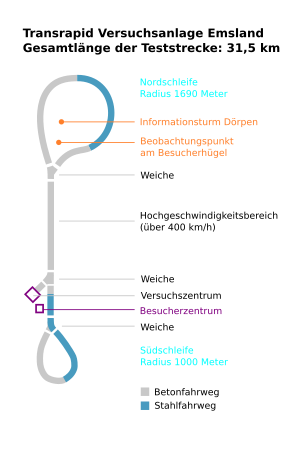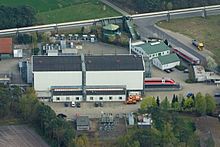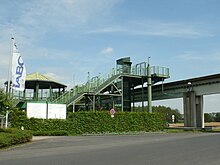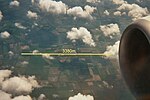Transrapid test facility in Emsland
| TVE | |
|---|---|
|
Location of the TVE
| |
|
Detailed plan of the Emsland Transrapid test facility
| |
| Route length: | 31.8 km |
| Minimum radius : | 1000 m |
| Dual track : | - |
The Transrapid test facility in Emsland ( TVE ) was a test site for the Transrapid magnetic levitation train with a 31.8 kilometer test track in the western part of the Emsland district in Lower Saxony ( Germany ).
The test facility was operated by Industrieanlagen-Betriebsgesellschaft mbH ( IABG ) and, from 1985, by the testing and planning company for Magnetbahnsysteme mbH , a subsidiary of the Deutsche Bundesbahn and Lufthansa .
Because of the end of funding for the facility by the federal government in 2010, dismantling, continued operation - financed by the district and industry - or conversion into a research center for electromobility were discussed as alternatives for further use.
The operating license for the Transrapid test facility in Emsland expired at the end of 2011; the line was closed. A center for electromobility is now to be set up on the site for around 4 million euros .
geography
The Transrapid test facility Emsland is located in the Emsland between the cities of Papenburg in the north and Meppen in the south and east of the communities Dörpen in the north and Lathen in the south. A few kilometers to the west, the Ems flows past the facility. The route of the partially completed Gleesen-Papenburg side canal runs through the site . The Geestrücken of the Hümmling begins five kilometers to the east .
To the west of the test facility run the federal highway 70 , via the side streets of which you can get to the facility, and the federal highway 31 .
The test track located in the test facility leads mainly through flat terrain, only its southern loop runs in the Hengstberge (up to 42 meters high) in the south-east of Lathen through hilly and wooded areas.
The test hall and visitor center are also located on the site of the Transrapid test facility. Furthermore, the Lathen – Werlte railway , which is only used for freight traffic, crosses under the route twice.
Test track
The test track consists of a single-lane straight section that can be driven through two end loops (north and south loop) in ring traffic. For this purpose, there is a switch at the end of the straight line, and another is used to access the test center.
The straight section is twelve kilometers long and suitable for high-speed trips up to 450 km / h (record run on June 10, 1993). The curve radius of the Südschleife is 1000 meters, that of the Nordschleife 1690 meters, in the curves the side slope of the road is twelve degrees.
history
Construction phase
The Transrapid test facility was built from 1980 to 1987 in two construction phases by the maglev system industry with the support of the Federal Ministry of Research .
In 1978 the decision was made to build a large-scale magnetic train test facility. The development of the system started in mid-1978.
In mid-1979 the planning of a test facility was started. As part of the selection process, a configuration was chosen that should contain all the essential elements of an application-oriented route (inclinations, curves, crests, switches, etc.) within the specified cost framework. The national test facility for traffic technology planned in the Donauried had previously failed.
The construction work on the track began in June 1980. In a first construction phase, the test center was built with a test straight along the as yet unfinished Ems side canal and the Nordschleife. For the first twelve-kilometer section, 422 million D-Marks were estimated. The vehicle accounted for around 60 million of this . In mid-1983, the preparatory work began on the second expansion stage (turning loop south).
On June 30, 1983, the Transrapid 06 (remote-controlled) operated for the first time on the partially completed test facility. At the end of October 1983, the Transrapid officially floated on the layout for the first time. Previously, an 18.5 m long special vehicle - a transport vehicle for people, equipment and material - with 16 wheels had rolled over the road. This vehicle, which can travel up to 50 km / h, was also used to clear snow up to 55 cm high.
On May 4, 1984, the Transrapid 06 broke the 200 km / h mark for the first time at 205 km / h. On August 16, 1984 the TR 06 reached 257 km / h, on October 17 of the same year the vehicle set a new speed record of 302 km / h on the test facility.
At the beginning of December 1987, a Transrapid floated over the south loop of the test facility for the first time. On the second day of operation, the maglev set a new world record for magnetic levitation vehicles manned by people at 406 km / h. A little later the train reached a speed of 412.6 km / h.
On December 13, 1989 the Transrapid 07 reached 436 km / h and in June 1993 a new record speed of 450 km / h.
Accident and Consequences
On September 22, 2006 there was a serious accident with the Transrapid 08 with 23 deaths and 10 injuries, as well as a total loss of the vehicle.
On April 19, 2007, the first of the three sections of the new Transrapid 09 arrived on the line. Her first driving tests took place in July 2008. At the end of May 2009, approval for passenger transport was granted.
As a result of the accident, around two thirds of the approximately 60 employees between September 2007 and January 2008 were on short-time work. In December 2007, the operating company submitted an application to the responsible Lower Saxony state authority for road construction and traffic for a renewed operating license for the system. This approval for test operations on the route was issued on July 3, 2008 with various conditions (e.g. no visitor rides). From July 29, 2008 the Transrapid 09 was on the route.
Search for later use and dismantling
With the expiry of the further development program (WEP) commissioned by the federal government from ThyssenKrupp and Siemens in 2005, it was clear that the line would lose its function at the end of June 2009. According to the system houses, a ready-to-use system will then be available that can be marketed internationally and that illustrates Germany's technological lead. The test facility would no longer be required for further developments. IABG is responsible for the foreseeable dismantling of the plant. A first, rough estimate was based on costs of around 40 million euros. According to a management contract signed in 1984, this must be borne by the federal government. On June 24th, 2009 it was announced that the district, state, federal government and industry had agreed to continue operating the test route until April 2010 in order to enable the testing of newly developed road beams.
As part of the budget deliberations of the federal government in November 2010 it was decided to make the expected dismantling costs available to the Emsland-Lathen district. He intended to convert the test facility into a research center. A conversion into a research center for electromobility was considered. Of the companies involved in the construction of the Transrapid, only the construction company Max Bögl, who is researching the construction of the track, has expressed its willingness to participate in the further financing of the test facility. At the beginning of December 2010, a precautionary application was made to dismiss the employees of the test track, as those involved had not yet agreed on a re-use concept and federal funds were therefore blocked.
The transport scientist Peter Mnich confirmed the opinion of Siemens and ThyssenKrupp that the test route was not necessary for the further development of the Transrapid. Rather, data and experience from regular operations are necessary. However, critics of a task on the test route, including Max Bögl , a company involved in the construction of the Transrapid route , referred to the tests required to optimize newly developed components of the roadway. They also saw a need to keep the facility for presenting the system to interested parties. In the case of an order for training courses, the system is required before the route to be built is completed. Furthermore, it was feared that the shutdown of the test facility abroad would be interpreted as a signal for the abandonment of the maglev technology.
The test track was originally supposed to be dismantled in 2012, and the approximately 60 employees at the test facility were given notice at the end of November 2011. Since the center for electromobility, which is to be located on the site, is to test the charging of batteries while driving, the route was initially not dismantled; it should be checked which components are suitable for later use. The line is now to be demolished.
The operator IABG founded the subsidiary Integrated Infrastructure Solutions GmbH (INTIS) in 2012, which, in addition to dismantling the test facility, was also supposed to carry out the aforementioned technology transfer into new applications. There are currently attempts at inductive charging in buses and cars, such as the joint project "Inductive charging while driving".
The dismantling had not started at the end of 2019, as there was a disagreement between IABG and the federal government about the scope. It is a matter of dispute whether underground foundations that are up to 16 m deep must also be completely removed.
Between 1970 and 2008, federal funds of around 800 million euros flowed into the facility. More than half of this was used for the construction of the plant, the rest was used for operation and maintenance. For the 2009 federal budget, funds amounting to 6 million euros had been earmarked for the operation of the plant. Depending on the number of use cases, the industrial companies involved are obliged to repay up to 100 million euros in funds from the further development program .
The last train, Transrapid 09 (TR09), was auctioned by H. Kemper GmbH & Co. KG for € 200,001 in November 2016 and set up on their company premises in Nortrup in September 2017 . There two of the three 25 m long sections of the train are to be used as conference and exhibition rooms on the history of the Transrapid. The third section is to be made accessible to the public with the Hermann Kemper Museum, which will open from 2019. Hermann Kemper , the inventor of the maglev train, came from the same family as the owners of the sausage and meat products manufacturer Kemper.
Mileage data on the TVE
| Transrapid vehicles TR06 , TR07 and TR08 | |
|---|---|
| Maximum speed (TR07) (June 10, 1993) | 450 km / h |
| Longest non-stop trip (TR07) (June 6, 1993) | 1,654 kilometers |
| Max daily mileage (TR07) (August 15, 1990) | 2,476 kilometers |
| Total mileage TVE (TR06, TR07 and TR08) (until December 13, 2001) | approximately 778,500 kilometers |
| Visitor rides TR06 (1983–1989) | 21.093 |
| Visitor rides TR07 (1989–1999) | 258.100 |
| Visitor rides TR08 (until September 22, 2006) | 293,611 |
Picture gallery
Web links
- RUINE of the TRANSRAPID test track in Emsland , YouTube published on December 2, 2016
- Old TRANSRAPID test track Emsland - last aerial photos before demolition , YouTube published on January 5, 2020
Individual evidence
- ↑ a b c d Decommissioning of the Transrapid test facility in Emsland (PDF; 65 KiB). Answer of the Federal Government to the minor question from the MPs Brigitte Pothmer, Dr. Anton Hofreiter, Winfried Hermann, other MPs and the Alliance 90 / THE GREENS parliamentary group. Printed matter 16/11619 from January 19, 2009
- ^ Federal government wants to say goodbye to the Transrapid. In: Handelsblatt . November 12, 2010. Retrieved November 12, 2010.
- ^ Federal government wants to get off the Transrapid. ( Memento of the original from November 15, 2010 in the Internet Archive ) Info: The archive link was inserted automatically and has not yet been checked. Please check the original and archive link according to the instructions and then remove this notice. In: NOZ.de Osnabrücker Zeitung , accessed on November 12, 2010.
- ↑ Transrapid line before the demolition. Norddeutscher Rundfunk , January 10, 2012, archived from the original on December 2, 2016 ; Retrieved June 20, 2017 .
- ↑ a b c d Report on the Transrapid test facility in the Emsland: Preparations for the construction of the southern loop. In: Railway technical review . 33, No. 6, 1984, pp. 553 f.
- ↑ a b Erich Eitlhuber: The TRANSRAPID test facility in Emsland. In: Railway technical review . 29, No. 6, 1980, pp. 409-414.
- ↑ Message The way is being prepared for “Transrapid”. In: The Federal Railroad . Vol. 57, No. 11, 1981, ISSN 0007-5876 , p. 921 f.
- ↑ Report on the Transrapid test facility in Emsland. In: Railway technical review . 32, No. 7/8, 1983, p. 556
- ^ Message special vehicle for maglev Emsland. In: Railway technical review . 33, No. 11, 1984, p. 870.
- ↑ Report Transrapid 06 meanwhile 200 km / h fast. In: Railway technical review . 33, No. 6, 1984, p. 553.
- ↑ Announcement Significantly improved export opportunities for the Transrapid maglev. In: Railway technical review . 1/2, No. 37, 1988, p. 89 f.
- ↑ Nds. State authority for road construction and traffic - responsibility for the approval of the operating regulations as a technical supervisory authority
- ↑ The test track will remain in operation until 2010 . In: Focus-online , June 24, 2009, accessed June 24, 2009
- ↑ More staff for aviation security. In: Handelsblatt , No. 220, 12./13. November 2010, p. 16 f.
- ↑ Terminations of Transrapid test route? ( Memento of December 10, 2010 in the Internet Archive ) in NDR.de, December 7, 2010, accessed on December 7, 2010
- ↑ Transrapid last exit Tenerife , in focus.de , 10 November 2010, accessed on 18 November 2010
- ^ Ministry of Transport visits Max Bögl in Neumarkt. ( Memento of the original from January 18, 2012 in the Internet Archive ) Info: The archive link was inserted automatically and has not yet been checked. Please check the original and archive link according to the instructions and then remove this notice. in neumarkt.tv , March 29, 2010, accessed on November 18, 2010
- ↑ Transrapid test facility before the demolition. In: financial.de, January 10, 2012, accessed on January 16, 2012.
- ↑ Lathen: Re-use is slowly picking up speed. NDR, March 13, 2012, accessed July 1, 2012 .
- ↑ IABG subsidiary founded for new tasks ( Memento of the original from October 16, 2015 in the Internet Archive ) Info: The archive link was inserted automatically and has not yet been checked. Please check the original and archive link according to the instructions and then remove this notice. In: www.iabg.de, March 13, 2012, accessed on November 20, 2015.
- ↑ Transrapid technology lives on in e-cars . In: www.welt.de, February 25, 2014, accessed on November 20, 2015.
- ↑ a b Last stop for the Transrapid: sausage factory. In: Frankfurter Allgemeine Zeitung of September 15, 2017, p. 21.
Coordinates: 52 ° 52 ′ 17.6 " N , 7 ° 20 ′ 58.5" E











